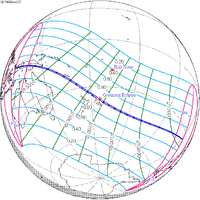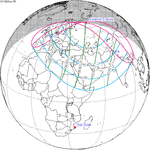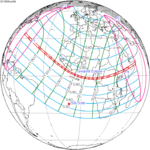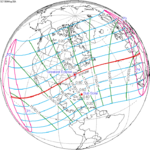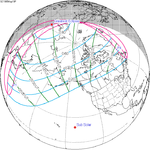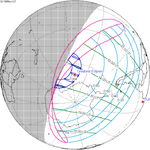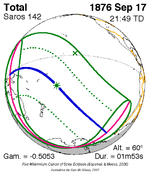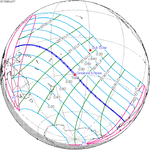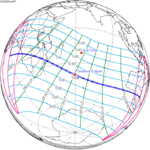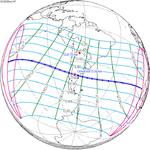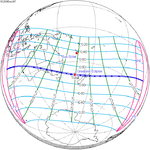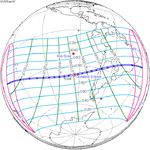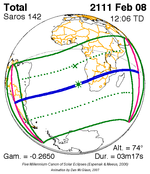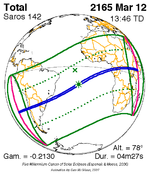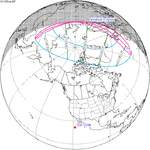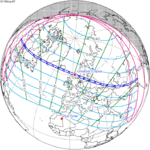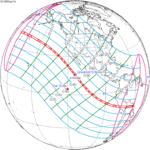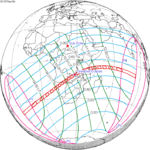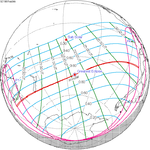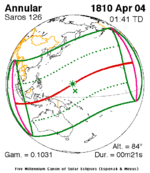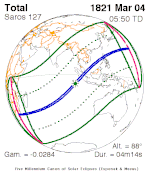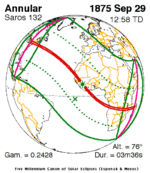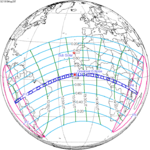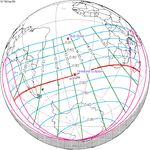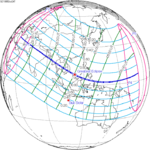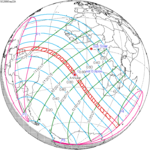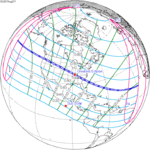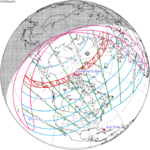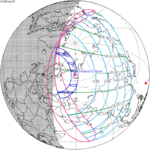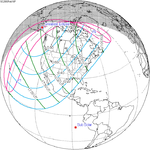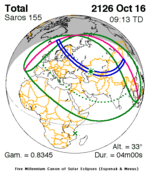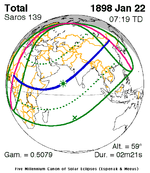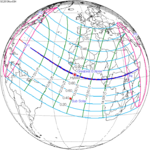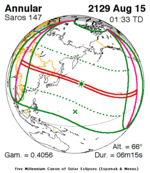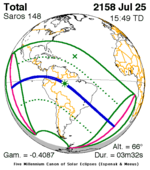|
Solar eclipse of November 22, 1984
A total solar eclipse occurred at the Moon's descending node of orbit between Thursday, November 22 and Friday, November 23, 1984,[1] with a magnitude of 1.0237. A solar eclipse occurs when the Moon passes between Earth and the Sun, thereby totally or partly obscuring the image of the Sun for a viewer on Earth. A total solar eclipse occurs when the Moon's apparent diameter is larger than the Sun's, blocking all direct sunlight, turning day into darkness. Totality occurs in a narrow path across Earth's surface, with the partial solar eclipse visible over a surrounding region thousands of kilometres wide. Occurring about 2.1 days after perigee (on November 20, 1984, at 20:50 UTC), the Moon's apparent diameter was larger.[2] Totality was visible in Indonesia, Papua New Guinea and southern Pacific Ocean. West of the International Date Line the eclipse took place on November 23, including all land in the path of totality. A partial eclipse was visible for parts of Indonesia, Australia, Oceania, Antarctica, and extreme southern South America. ObservationsJay Pasachoff led an observation team from Williams College in Massachusetts to Papua New Guinea, taking images of the process of the eclipse and the corona, as well as the Baily's beads and the illuminance of the corona. Besides the observations, the team members also went to places near the Sepik River in northern Papua New Guinea.[3] Eclipse detailsShown below are two tables displaying details about this particular solar eclipse. The first table outlines times at which the moon's penumbra or umbra attains the specific parameter, and the second table describes various other parameters pertaining to this eclipse.[4]
Eclipse seasonThis eclipse is part of an eclipse season, a period, roughly every six months, when eclipses occur. Only two (or occasionally three) eclipse seasons occur each year, and each season lasts about 35 days and repeats just short of six months (173 days) later; thus two full eclipse seasons always occur each year. Either two or three eclipses happen each eclipse season. In the sequence below, each eclipse is separated by a fortnight.
Related eclipsesEclipses in 1984
Metonic
Tzolkinex
Half-Saros
Tritos
Solar Saros 142
Inex
Triad
Solar eclipses of 1982–1985This eclipse is a member of a semester series. An eclipse in a semester series of solar eclipses repeats approximately every 177 days and 4 hours (a semester) at alternating nodes of the Moon's orbit.[5] The partial solar eclipses on January 25, 1982 and July 20, 1982 occur in the previous lunar year eclipse set.
Saros 142This eclipse is a part of Saros series 142, repeating every 18 years, 11 days, and containing 72 events. The series started with a partial solar eclipse on April 17, 1624. It contains a hybrid eclipse on July 14, 1768, and total eclipses from July 25, 1786 through October 29, 2543. There are no annular eclipses in this set. The series ends at member 72 as a partial eclipse on June 5, 2904. Its eclipses are tabulated in three columns; every third eclipse in the same column is one exeligmos apart, so they all cast shadows over approximately the same parts of the Earth. The longest duration of totality will be produced by member 38 at 6 minutes, 34 seconds on May 28, 2291. All eclipses in this series occur at the Moon’s descending node of orbit.[6]
Metonic seriesThe metonic series repeats eclipses every 19 years (6939.69 days), lasting about 5 cycles. Eclipses occur in nearly the same calendar date. In addition, the octon subseries repeats 1/5 of that or every 3.8 years (1387.94 days). All eclipses in this table occur at the Moon's descending node.
Tritos seriesThis eclipse is a part of a tritos cycle, repeating at alternating nodes every 135 synodic months (≈ 3986.63 days, or 11 years minus 1 month). Their appearance and longitude are irregular due to a lack of synchronization with the anomalistic month (period of perigee), but groupings of 3 tritos cycles (≈ 33 years minus 3 months) come close (≈ 434.044 anomalistic months), so eclipses are similar in these groupings.
Inex seriesThis eclipse is a part of the long period inex cycle, repeating at alternating nodes, every 358 synodic months (≈ 10,571.95 days, or 29 years minus 20 days). Their appearance and longitude are irregular due to a lack of synchronization with the anomalistic month (period of perigee). However, groupings of 3 inex cycles (≈ 87 years minus 2 months) comes close (≈ 1,151.02 anomalistic months), so eclipses are similar in these groupings.
Notes
References
Wikimedia Commons has media related to Solar eclipse of 1984 November 22. |
||||||||||||||||||||||||||||||||||||||||||||||||||||||||||||||||||||||||||||||||||||||||||||||||||||||||||||||||||||||||||||||||||||||||||||||||||||||||||||||||||||||||||||||||||||||||||||||||||||||||||||||||||||||||||||||||||||||||||||||||||||||||||||||||||||||||||||||||||||||||||||||||||||||||||



